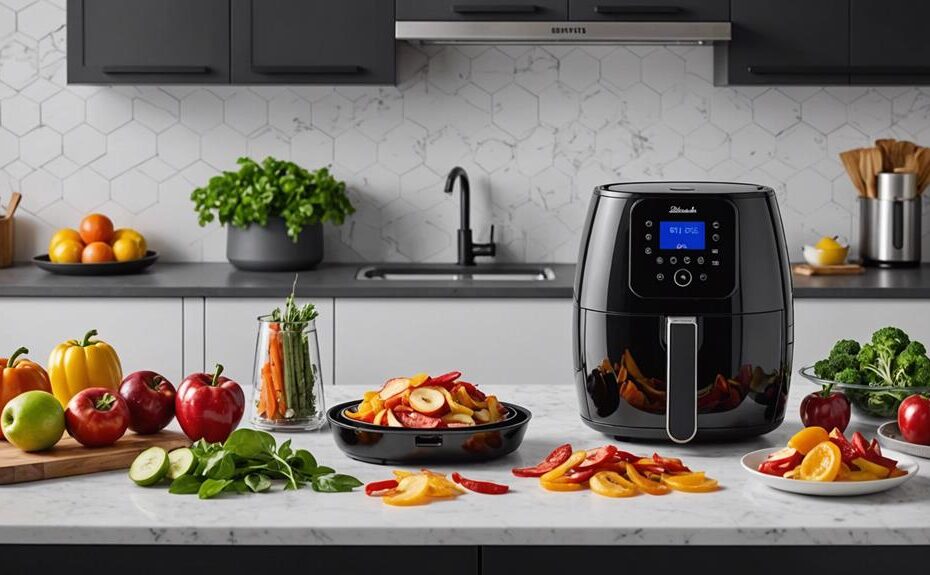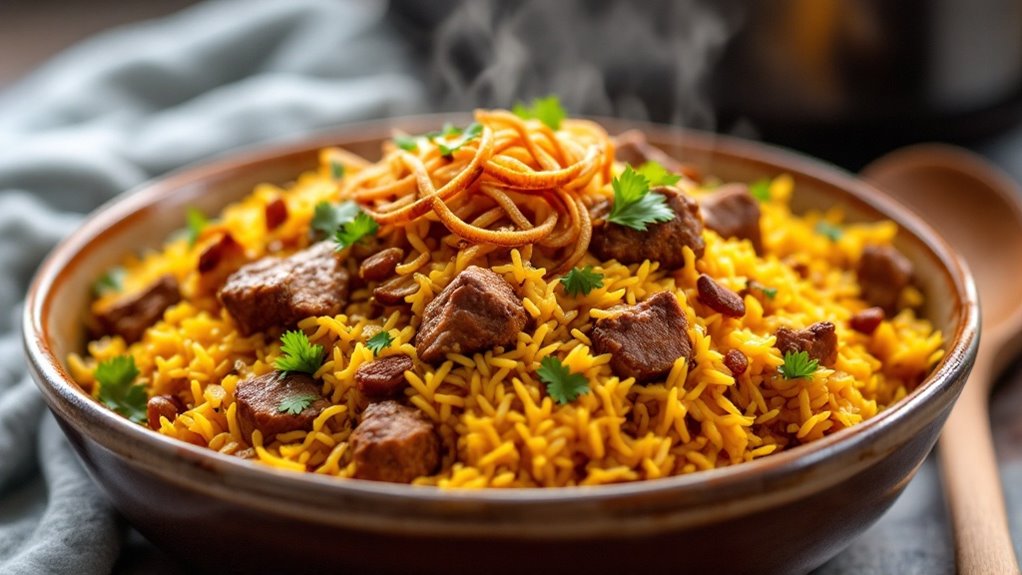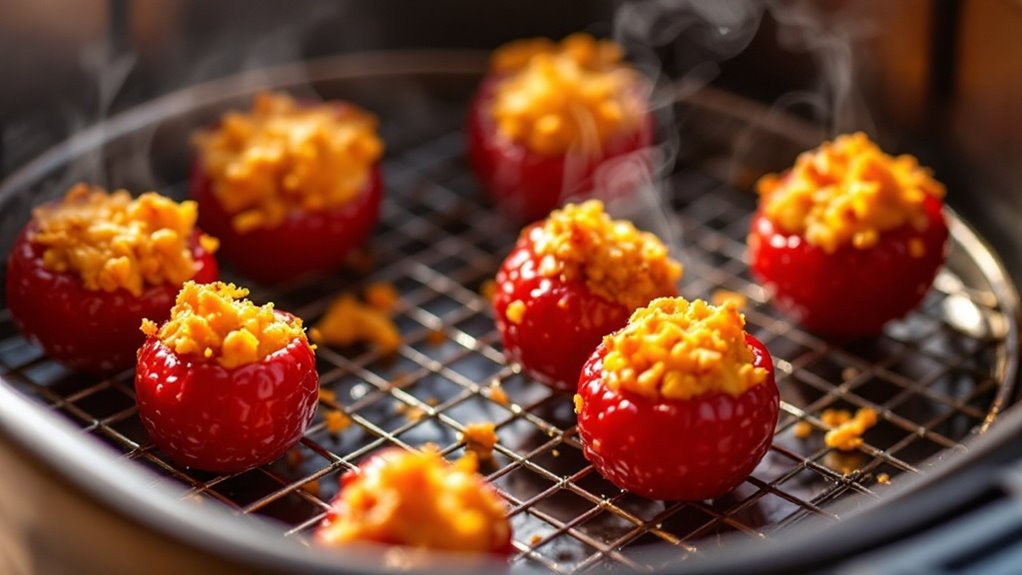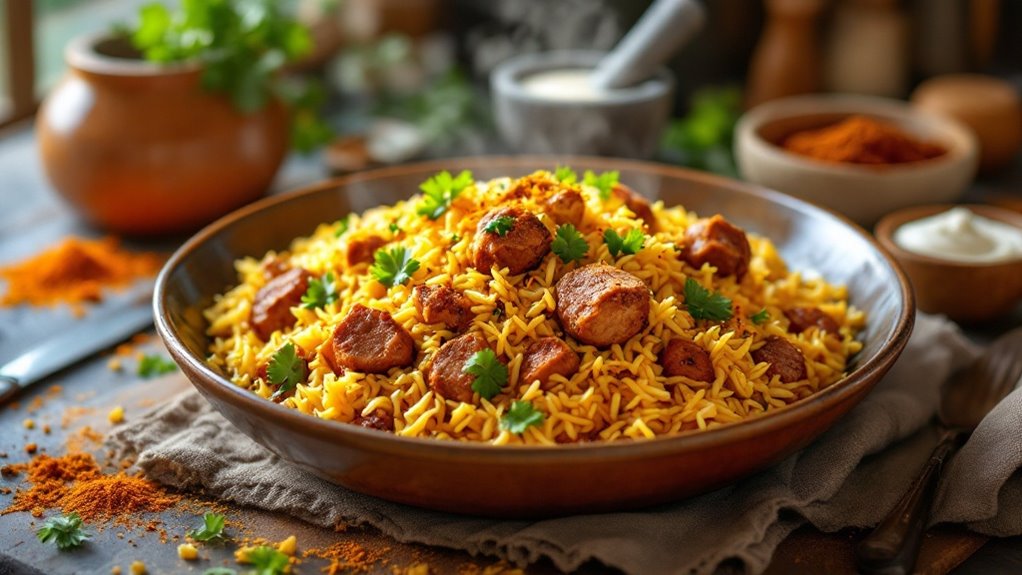Yes, you can dehydrate food in an air fryer. By using the air fryer's even airflow and precise temperature controls, you can effectively remove moisture from various foods. Set your air fryer to a low temperature, typically between 120°F and 140°F. Slice the food thinly and arrange it in a single layer to guarantee proper airflow. Common choices include fruits, vegetables, and meats. Unlike dedicated dehydrators, air fryers offer the flexibility of multiple cooking functions while still efficiently preserving your food. With these steps, you can create tasty, nutritious snacks at home. Explore more to optimize your technique and storage methods.
Key Takeaways
- Air fryers can dehydrate food by circulating warm air evenly to remove moisture.
- They maintain steady temperatures between 120°F and 160°F for effective dehydration.
- Specific dehydration settings on air fryers make the process simple and efficient.
- Dehydrating in an air fryer preserves food, creates healthy snacks, and reduces waste.
- Proper slicing and arrangement of food ensure optimal airflow and consistent drying.
How Air Fryers Dehydrate
Air fryers dehydrate food by circulating warm air evenly throughout the appliance, efficiently removing moisture from items like fruits, vegetables, and meats. When you use an air fryer to dehydrate food, you rely on its ability to maintain a steady temperature over an extended period. Typically, air fryers come with specific settings for dehydration, allowing you to control the temperature precisely, usually between 120°F and 160°F. This critical environment is essential for guaranteeing that the food dehydrates evenly and retains its nutritional value.
The process involves more than just setting the temperature; time is also an important factor. Depending on the type of food and the desired level of dehydration, you might need to let the air fryer run for several hours. For example, fruits like apple slices might take around 4-6 hours, while meat for jerky could require up to 8 hours. The key is to monitor the food periodically to make sure it reaches the desired level of dehydration without overcooking.
Once dehydrated, these foods can be used as healthy snacks or stored for extended periods. Mastering the use of your air fryer for dehydration can make food preservation both efficient and straightforward.
Benefits of Dehydrating Food
Employing your air fryer for dehydration not only guarantees efficient food preservation but also offers a multitude of benefits that extend beyond mere shelf life extension. Dehydrating food in an air fryer greatly reduces wastage and saves money by allowing you to store food for extended periods. This method helps you avoid the frequent need to buy new ingredients, making it a cost-effective solution for food storage.
Additionally, dehydrating with an air fryer offers the flexibility to create your seasonings and snacks. Imagine having a variety of healthy snacks like dehydrated fruits and fruit roll-ups ready at your convenience. These snacks are not only delicious but also nutritious, providing a healthier alternative to store-bought options laden with preservatives.
Moreover, the versatility of an air fryer allows you to explore creative projects, such as making potpourri for festive occasions like Christmas. The dehydrating process can transform fruits and spices into aromatic decorations, adding a personal touch to your festivities.
In essence, using an air fryer for dehydration enhances your food preservation efforts, extends the shelf life of various foods, and opens up a world of culinary creativity with homemade seasonings, snacks, and more.
Best Foods to Dehydrate
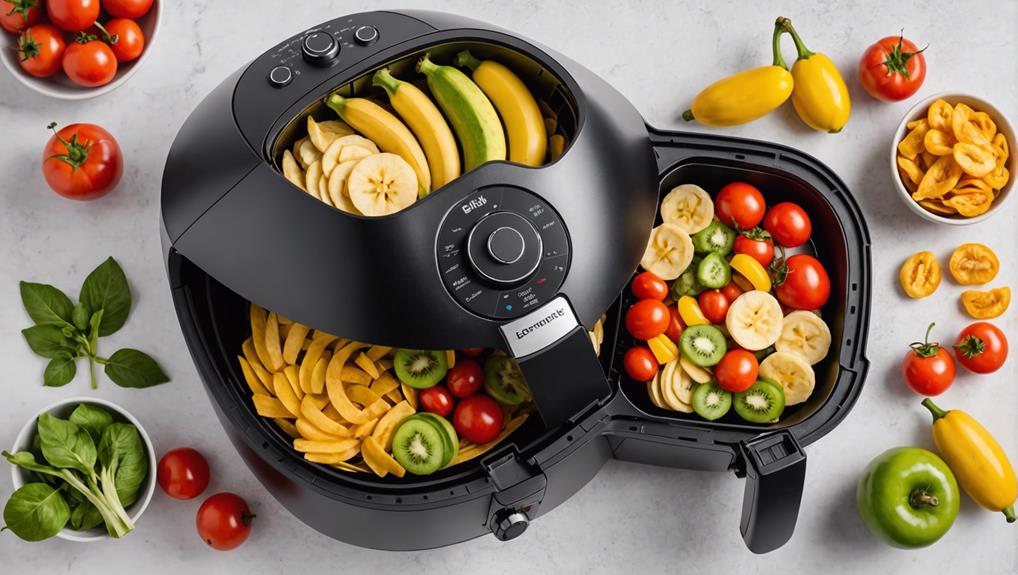
When deciding what to dehydrate in your air fryer, fruits like apples and bananas, vegetables such as zucchini and tomatoes, and meats like beef and turkey stand out as excellent choices. Using your air fryer as a food dehydrator allows you to make healthy snacks like apple chips, banana chips, and beef jerky, all while retaining the nutrients and extending shelf life.
For fruits, apple chips and banana chips are popular options. They transform into crunchy, sweet treats that are perfect for snacking. Zucchini and tomatoes can be dehydrated to create versatile additions to soups, salads, or as stand-alone snacks. When you dehydrate meat, such as making beef jerky, you're crafting a protein-packed snack free from preservatives often found in store-bought versions.
Experimenting with different air fryer recipes and dehydration times can help you discover the best foods you can dehydrate to suit your tastes. Remember, to dehydrate in an air fryer effectively, maintaining a consistent temperature around 175°F is important. This low heat ensures that the food dries out evenly without cooking. By exploring various foods and techniques, you'll master the art of creating delicious, healthy snacks.
Steps to Dehydrate Food
To effectively dehydrate food in your air fryer, start by selecting the dehydration setting if your model includes this feature. Adjust the temperature to around 120-140°F, as this range is ideal for dehydrating a variety of foods.
Next, prepare your food by slicing it thinly. Uniform, thin slices guarantee even dehydration and prevent any pieces from remaining too moist. Arrange the slices in a single layer on the air fryer rack to allow for proper airflow. Stacking or overlapping the slices can lead to uneven dehydration and take longer to achieve the desired dryness.
Proper ventilation is essential during the dehydration process. The air fryer circulates hot air to remove moisture from the food, so make sure not to obstruct the air vents. This ensures consistent air circulation and effective moisture removal.
Throughout the dehydration process, monitor the food periodically. Check for texture and dryness, and adjust the time as needed. Dehydrating times can vary based on the type and thickness of the food slices, so keep an eye on them to prevent over-drying or under-drying.
Air Fryer Vs. Dehydrator
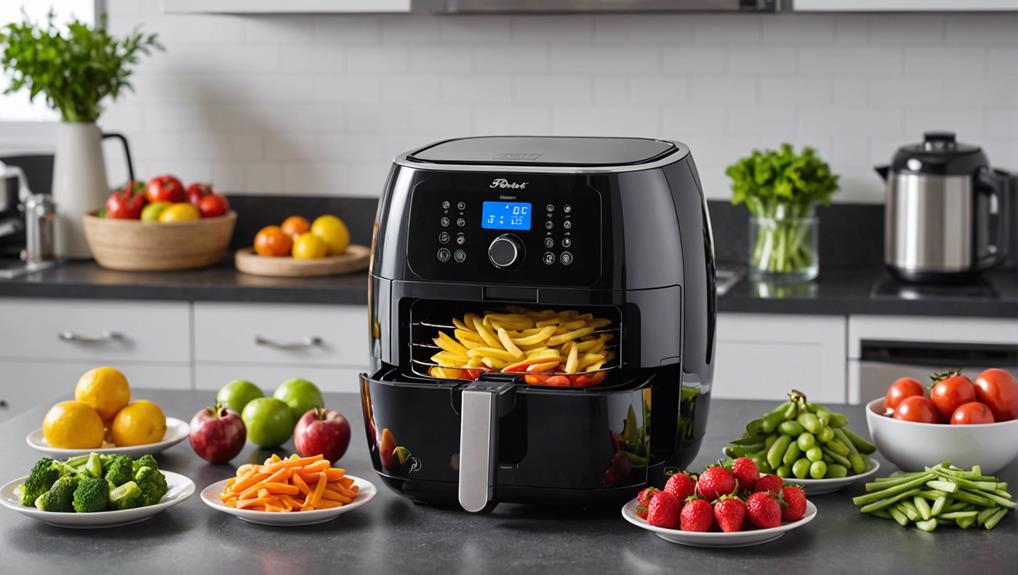
Comparing an air fryer to a dehydrator reveals key differences in their design and functionality, impacting their efficiency and versatility in food preparation. An air fryer uses hot air to cook food quickly, making it ideal for frying, baking, and roasting. Conversely, a dehydrator is specifically designed for dehydrating food by removing moisture at low temperatures. This slow dehydration process is best suited for extending the shelf life of specific foods like fruits, vegetables, and meats.
When using an air fryer to dehydrate food, you'll typically use a dehydration setting that circulates warm air. While this can be effective, it's less precise than a dehydrator, which is built to maintain consistent low temperatures over extended periods. Dehydrators allow you to fine-tune both the temperature and time, ensuring ideal conditions for slow dehydration and preserving the nutritional integrity of your food.
Although air fryers offer the advantage of multiple cooking options, they may not provide the same level of control and efficiency for dehydrating specific foods. Nonetheless, both appliances can help you reduce food waste by extending the shelf life of your ingredients, transforming them into convenient snacks or components for various recipes.
Tips for Dehydrating
Mastering the art of dehydrating food in an air fryer requires attention to temperature settings, ventilation, and monitoring to achieve the best results. Set your air fryer to a temperature range of 120-140°F. This range is ideal for dehydrating fruits, vegetables, and even meats. Maintaining this temperature ensures the food dehydrates evenly without cooking.
Proper ventilation is essential. The air fryer basket should allow moisture to escape efficiently. Ensuring good airflow is key to preventing mold and achieving the desired dryness. Stainless steel racks or wood skewers can help increase the capacity of your air fryer, allowing you to dehydrate more food at once without compromising airflow.
Monitoring your food periodically is important. Check the progress and adjust the dehydration time as needed. Avoid frequently removing the basket during the process, as this can disrupt airflow and lead to inconsistent results.
Consistency is crucial for successful dehydration. Slice fruits and vegetables uniformly to ensure even drying. Following these tips will help you maximize your air fryer's potential for dehydrating, resulting in perfectly preserved snacks every time.
Storing Dehydrated Foods
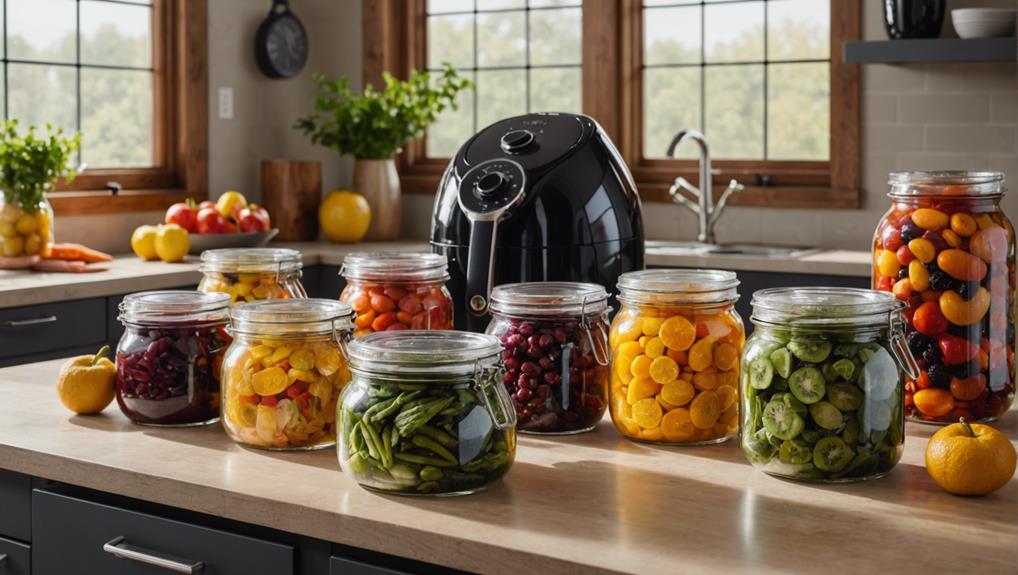
Proper storage of dehydrated foods hinges on maintaining an airtight environment to prevent moisture absorption and preserve quality. When you've used your air fryer to dehydrate foods, the next critical step is making sure they stay fresh. Store your dehydrated foods in airtight containers. This simple measure guards against moisture absorption, which can spoil the food.
For best shelf life, place these containers in a cool, dark place, away from direct sunlight. Excess heat and light can degrade the quality of the food, reducing its longevity. If you want to take an extra step, consider vacuum sealing. Vacuum sealing removes air from the packaging, providing an added layer of protection and extending the shelf life significantly.
Don't forget to label each container with the date of dehydration. This practice helps you track the age of your foods and ensures you use them in a timely manner. Rotation is important; always use the oldest stock first to maintain freshness. By following these storage guidelines, your dehydrated foods can remain viable for several months to a year, depending on the type. Proper storage guarantees you get the most out of your air fryer efforts.
Frequently Asked Questions
Is an Air Fryer Better Than a Dehydrator for Beef Jerky?
For beef jerky, air fryers offer better temperature control and shorter cooking times. However, dehydrators excel in marination time, batch sizes, energy efficiency, texture differences, flavor retention, nutrient preservation, cleanup process, and equipment cost.
Does an Air Fryer Dry Out Food?
Imagine a sponge losing water. In an air fryer, food undergoes a similar dehydration process, influenced by air circulation, temperature control, and fan speed. Proper techniques guarantee moisture retention, preserving nutrients, flavor, and food safety.
Can You Dehydrate Sweets in an Air Fryer?
You can dehydrate sweets in an air fryer, creating dried sweets like fruit leather, gummy bears, and sweet chips. It's perfect for candy dehydration, preserving desserts like caramel bites, and making healthy snacks with sugar crystals or chocolate treats.
Can You Put Raw Meat in Airfryer?
Cooking raw meat in an air fryer is a breeze. Guarantee food safety by controlling temperature, preheating the air fryer, and using a meat marinade. Ideal air circulation and cleaning tips maintain meat texture and even cooking.
Conclusion
By now, you've seen how versatile your air fryer can be, even for dehydrating food. It's a convenient, efficient gadget that can save you both time and space. Whether you're drying fruits or creating homemade jerky, the air fryer's got your back. Just follow the steps closely, and you'll be munching on delicious, preserved snacks in no time. Remember, proper storage is key to longevity—think of it as the Tupperware of the future. Happy dehydrating!
Disclosure: As an Amazon Associate, I earn from qualifying purchases.
